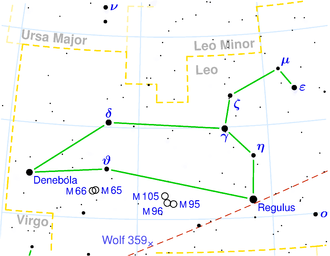NGC 3862
| Galaxie NGC 3862 | |
|---|---|
 | |
| NGC 3862 & IC 2955 aus dem SDSS | |
| AladinLite | |
| Sternbild | Löwe |
| Position Äquinoktium: J2000.0, Epoche: J2000.0 | |
| Rektaszension | 11h 45m 05,0s[1] |
| Deklination | +19° 36′ 23″[1] |
| Erscheinungsbild | |
| Morphologischer Typ | E / LERG / LINER[1][2] |
| Helligkeit (visuell) | 12,7 mag[2] |
| Helligkeit (B-Band) | 13,7 mag[2] |
| Winkelausdehnung | 1,5′ × 1,5′[2] |
| Flächenhelligkeit | 13,5 mag/arcmin²[2] |
| Physikalische Daten | |
| Zugehörigkeit | Abell 1367 |
| Rotverschiebung | 0.021718 ±0.000019[1] |
| Radialgeschwindigkeit | 6511 ±6 km/s[1] |
| Hubbledistanz vrad / H0 | (289 ± 20) · 106 Lj (88,5 ± 6,2) Mpc [1] |
| Geschichte | |
| Entdeckung | William Herschel |
| Entdeckungsdatum | 27. April 1785 |
| Katalogbezeichnungen | |
| NGC 3862 • UGC 6723 • PGC 36606 • CGCG 097-127 • MCG +03-30-095 • 2MASX J11450498+1936229 • GC 2537 • H III 385 • LDCE 836 NED034 | |
NGC 3862 ist eine elliptische Radiogalaxie vom Hubble-Typ E0 im Sternbild Löwe an der Ekliptik. Sie ist schätzungsweise 289 Millionen Lichtjahre von der Milchstraße entfernt und hat einen Durchmesser von etwa 130.000 Lichtjahren. Sie ist Mitglied des Abell 1367-Galaxienhaufens.
Im selben Himmelsareal befinden sich u. a. die Galaxien NGC 3857, NGC 3859, NGC 3868, IC 2955.
Das Objekt wurde am 27. April 1785 von dem Astronomen Wilhelm Herschel mit seinem 18,7-Zoll-Spiegelteleskop entdeckt.[3]
Aufnahmen des Hubble-Weltraumteleskops zeigen, dass die Galaxie in ihrem Zentrum eine Akkretionsscheibe und davon ausgehend einen 900 Parsec (rund 3000 Lichtjahre) langen, sich verändernden Jet hat, welcher Forschungsgegenstand zahlreicher Arbeiten ist.[4][5][6]
Weblinks
- 3C 264 auf dem 3CRR Atlas
Einzelnachweise
- ↑ a b c d NASA/IPAC EXTRAGALACTIC DATABASE
- ↑ a b c d e SEDS: NGC 3862
- ↑ Courtney Seligman: NGC 3862 (= PGC 36606). Courtney Seligman, 26. Oktober 2013, abgerufen am 26. August 2018 (englisch).
- ↑ L. Lara, G Giovanni, W. D. Cotton, L. Ferretti, T. Venturi, S. A. Baum, C. P. O'Dea, S. de Koff und W. B. Sparks: EVN and MERLIN Observations of the FR 1 Radiogalaxy 3C 264. (pdf) Abgerufen am 28. Mai 2015 (englisch).
- ↑ L. LARA, L. FERETTI, G. GIOVANNINI, S. BAUM, W. D. COTTON, C. P. O'DEA, und T. VENTURI: The Radio-Optical Jet in NGC 3862 from Parsec to Subkiloparsec Scales. In: THE ASTROPHYSICAL JOURNAL. 1. März 1999, abgerufen am 28. Mai 2015 (englisch).
- ↑ Bridle, A. H. & Vallee, J. P.: High-resolution radio observations of the X-ray galaxy NGC 3862 /3C 264/ in Abell 1367. In: Astronomical Journal. Band 86, August 1981, S. 1165–1174, bibcode:1981AJ.....86.1165B (englisch).
Auf dieser Seite verwendete Medien
Autor/Urheber: Copyright © 2003 Torsten Bronger., Lizenz: CC BY-SA 3.0
This is a celestial map of the constellation Leo, the Lion.
Autor/Urheber: Sloan Digital Sky Survey, Lizenz: CC BY 4.0
The sky image is obtained by Sloan Digital Sky Survey, DR14 with SciServer.
Angle of view: 4' × 4' (0.3" per pixel), north is up.
Details on the image processing pipeline: https://www.sdss.org/dr14/imaging/jpg-images-on-skyserver/(c) ESA/Hubble, CC BY 4.0
[Left] In this NASA Hubble Space Telescope image of the central region of the galaxy NGC 3862, an extragalactic jet of material moving at nearly the speed of light can be seen at the three o'clock position. The jet of ejected plasma is powered by energy from a supermassive black hole at the center of the elliptical galaxy, which is located 260 million light-years away in the constellation of Leo. [Right] A sequence of Hubble images of knots (outlined in red, green, and blue) shows them moving along the jet over a 20-year span of observing. Astronomers were surprised to discover that the central knot (green) caught up with and merged with the knot in front of it (blue). The new analysis suggests that shocks produced by collisions within the jet further accelerate particles that are confined to a narrowly focused beam of radiation. The "X" marks the location of the black hole.






